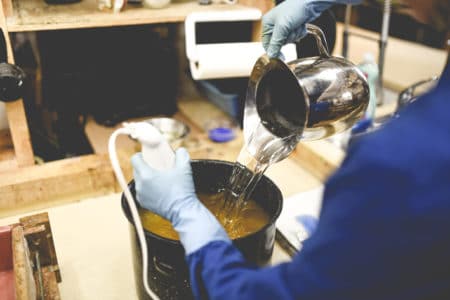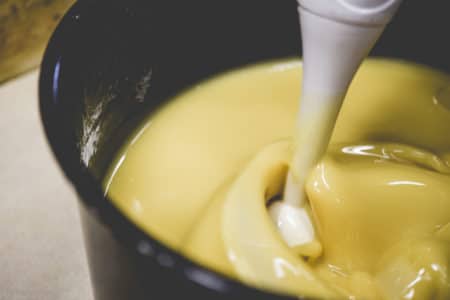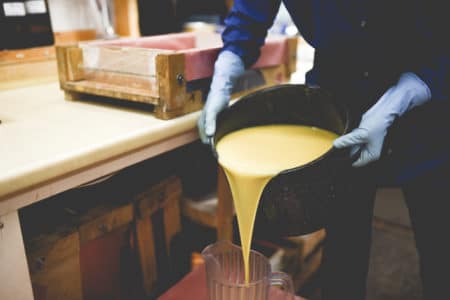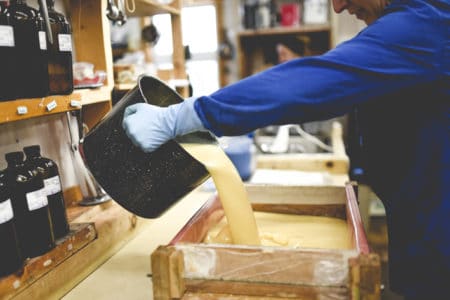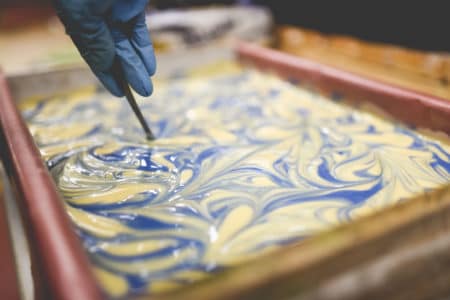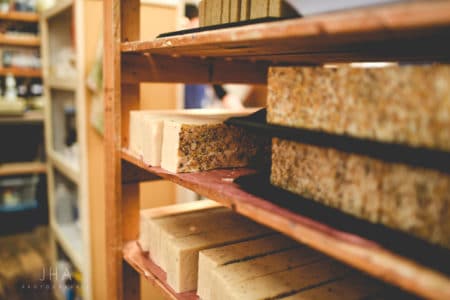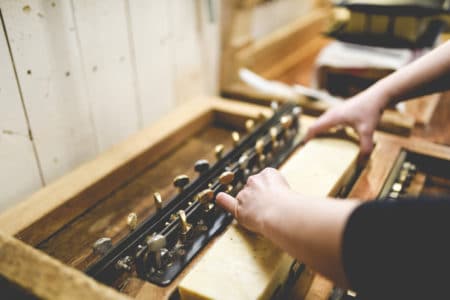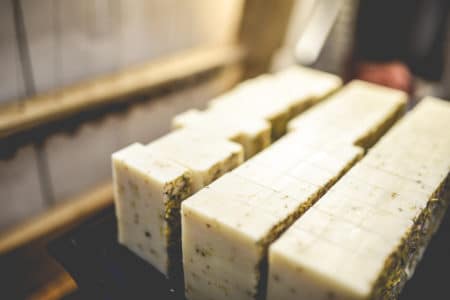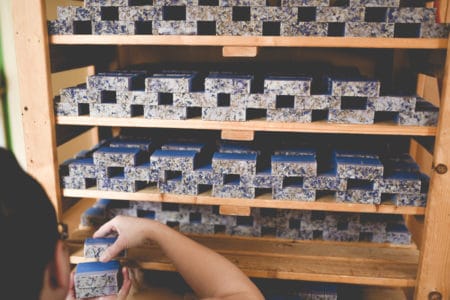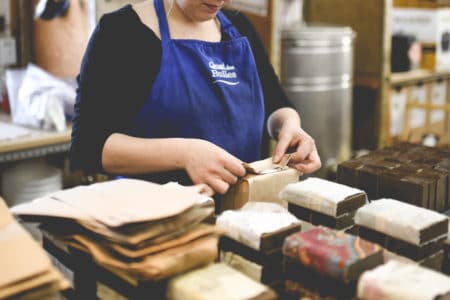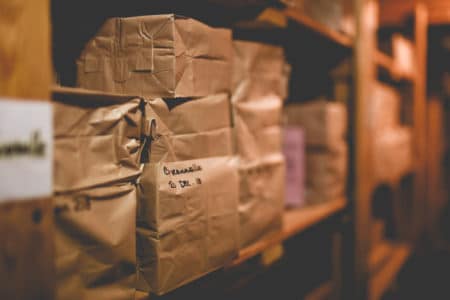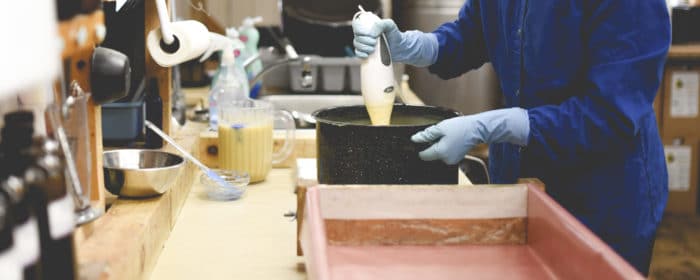
Soapmaking in 7 Steps (with Pictures)
Have you ever baked a cake? Making soap is (almost) as simple. Although you get to do a bit of chemistry, making soap is not rocket science! Here are the seven steps you need to go through to make handcrafted soap—the “cold process” way—with pictures.
Getting started
First, be sure to work on a clear surface with clean instruments. Handle sodium hydroxide (a corrosive product) and soap paste carefully in a ventilated area to prevent burns. It is essential to wear gloves, safety glasses, a mask, and long clothing during each step of soapmaking. Above all, make sure to have time on your hands. Even though soapmaking can (and should) be done fairly quickly, this is not the time to leave for dinner or help your child with homework!
–
Step 1 | Preparing the oily and aqueous phases
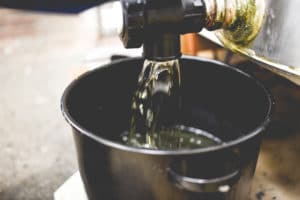
These two phases are prepared separately, and each ingredient is weighed carefully. The aqueous phase consists of cold water and sodium hydroxide (lye, NaOH). Lye is necessary as part of the “cold process” soapmaking method because it transforms the fatty substance into soap paste through a chemical reaction. On contact with sodium hydroxide granules, the temperature of the water rises considerably and rapidly. With a large spoon, stir until completely dissolved. As for the oily phase, it is the soap base. This oily phase is also heated. When the respective temperatures of the two phases have been reached, the lye solution is poured into the oily phase (never the other way round). The mixture is stirred with a hand blender until the soap paste begins to take shape.
–
Step 2 | Making the soap paste
On contact with the lye, the chemical reaction begins, and the oil is transformed into soap paste. This process is called cold saponification. As it is mixed, the paste becomes homogeneous and thickens until grooves form on the surface (like fudge!). This is known as the “trace” stage. Be careful with splatters! The active ingredients and colours can now be added to the paste.
–
Step 3 | Adding the active ingredients
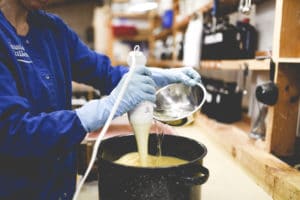 It is at this stage that essential oils, herbs, exfoliants, colours, and other active ingredients are added to the soap paste. The possibilities are endless! Caution: You must work fairly quickly because, depending on the ingredients, the chemical reaction can quickly thicken the soap paste. You can also separate one (or more) parts of the paste to create different colours.
It is at this stage that essential oils, herbs, exfoliants, colours, and other active ingredients are added to the soap paste. The possibilities are endless! Caution: You must work fairly quickly because, depending on the ingredients, the chemical reaction can quickly thicken the soap paste. You can also separate one (or more) parts of the paste to create different colours.
–
–
Step 4 | Pouring the soap
The soap paste is now ready to be poured into a mould. This is where you can let your creativity run wild for the look of your soap bars! Once again, you need to be alert and proceed fairly quickly because the soap paste continues to thicken. You must therefore plan your design before starting to work on the recipe.
–
Step 5 | Rest period
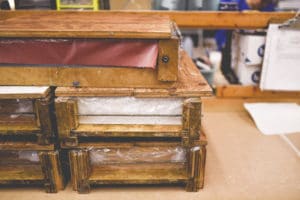 Once you have poured the soap paste, you need to cover it with resin, and the mould with a towel or wooden board. This will help retain the heat produced by the saponification (an exothermic reaction) process. Let it rest like this for at least 12 to 24 hours. It is during this period that the soap hardens. The soap rises in temperature, and its appearance (colour, texture) may seem quite different. Don’t worry, everything will be fine when the soap is removed from the mould.
Once you have poured the soap paste, you need to cover it with resin, and the mould with a towel or wooden board. This will help retain the heat produced by the saponification (an exothermic reaction) process. Let it rest like this for at least 12 to 24 hours. It is during this period that the soap hardens. The soap rises in temperature, and its appearance (colour, texture) may seem quite different. Don’t worry, everything will be fine when the soap is removed from the mould.
–
Step 6 | Unmoulding and cutting
A day later, the soap is ready to be unmoulded. Its consistency is comparable to that of a block of butter: it is strong enough to be handled, but soft enough to be easily cut. At Quai des Bulles, we cut our soap bars with handcrafted instruments, custom-made for our needs. We check all of our soap bars one by one to make sure they are perfect. At this stage of the process, the soap must be handled with care. It is then sent to dry.
–
Step 7 | Drying
A drying period is essential before the soap can be used. The soap bars are stacked on a wooden shelf and undergo an ambient air drying process that lasts at least 30 days. This period of time allows for the saponification process to fully complete and for the pH to adjust, making for a milder, less “caustic” soap. It is important to know that the drier soap bars become, the harder they become, and the longer their shelf life will be. Afterwards, the secret is to keep the soap bars in a dry and cool place, and to rotate them as needed. The use of a soap dish is essential to ensure proper drainage of your soap bar. Note that even after the 30-day drying cure, the appearance, smell, and colour of the soap may still continue to change (this does not affect its properties).
–
Materials required
Almost all you need can already be found in your kitchen!
- Kitchen scale
- Pitcher or large cup (metal, Pyrex, glass, or heat-resistant plastic)
- Spatulas, measuring spoons, utensils
- Hand blender
- Pot
- Kitchen thermometer
- Mould
CAUTION > During all stages of soap making, be sure to protect your hands, eyes, skin, and respiratory tract.
- Gloves
- Safety goggles
- Long clothing
- Mask (with cartridges)
You are welcome to come and see a soapmaking demonstration at our workshop in Kamouraska. (Call before!) 😉
Photo credit: Julie Houde-Audet, photographer ♥
–

